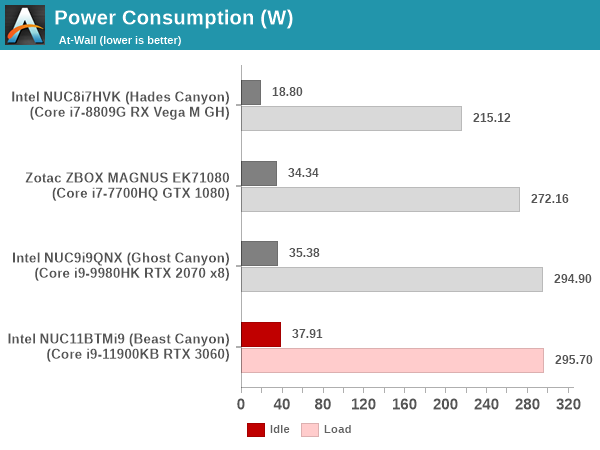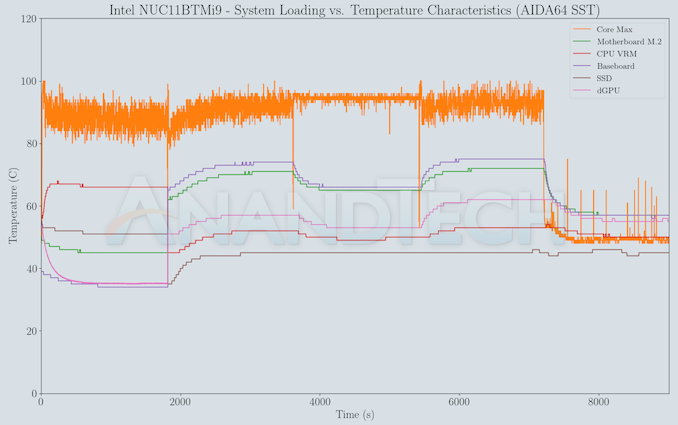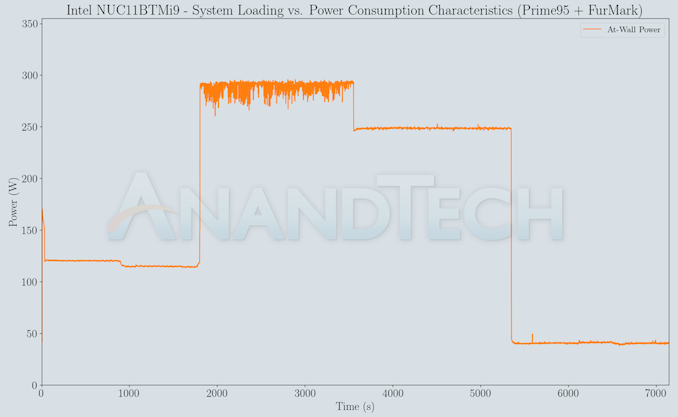Intel Beast Canyon NUC Review: Desktop Tiger Lake Debuts in SFF Gaming Powerhouse
by Ganesh T S on July 29, 2021 9:00 AM EST- Posted in
- Systems
- Intel
- NUC
- Tiger Lake
- NUC11
- Beast Canyon
Power Consumption and Thermal Performance
The power consumption at the wall was measured with a 4K display being driven through the HDMI port of the discrete GPU. In the graphs below, we compare the idle and load power of the Intel NUC11BTMi9 (Beast Canyon) with other similar PCs evaluated before. For load power consumption, we ran the AIDA64 System Stability Test with various stress components, as well as the artificial power virus test involving Prime95 and Furmark. The maximum sustained power consumption at the wall was recorded.

The numbers are very similar to the ones obtained for the Ghost Canyon NUC.
Our thermal stress routine starts with the system at idle, followed by four stages of different system loading profiles using the AIDA64 System Stability Test (each of 30 minutes duration). In the first stage, we stress the CPU, caches and RAM. In the second stage, we add the GPU to the above list. In the third stage, we stress the GPU standalone. In the final stage, we stress all the system components (including the disks). Beyond this, we leave the unit idle in order to determine how quickly the various temperatures in the system can come back to normal idling range. The various temperatures and power consumption number for the system during the above routine are presented in the graphs below.
While the CPU package manages to stay below the junction temperature during the system stability test, it does hover very close to the limits. This is likely due to the fans not taking effect soon enough, as the BIOS tries to maintain a balance between noise levels and cooling efficiency. It is likely that the production BIOS will need to sacrifice some noise levels for better thermals. Despite significant loading on the SSD, the thermal solution is good enough to keep the temperature below 75C.
A similar test routine is conducted with Prime95 running in maximum power consumption mode for 30 minutes, followed by the addition of a FurMark stress workload for another 30 minutes. After a cumulative run time of a hour, the Prime95 workload is removed, and FurMark allowed to proceed for another 30 minutes. The system is then left idle for another half an hour. The metrics tracked in the AIDA64 SST case are also tracked here.
The artificial power virus test significantly amps up the power consumption when both Prime95 and Furmark are simultaneously active. The GPU temperature is also a bit toasty and seems to suffer some after-effects of the Furmark loading. However, the core temperature quickly falls down to around 50C, thanks to the well-ventilated chassis and the three fans on the top panel.














84 Comments
View All Comments
meacupla - Friday, July 30, 2021 - link
Of all the parts that are likely to fail prematurely in a PC, the least likely is the CPU, followed by the mobo.For mobo failures, it's either DOA, or after 5yrs+. By the time you hit 5yrs+, there is a high likelyhood you can't find a replacement ITX mobo anyways, thus forcing you to buy both CPU+mobo, and potentially RAM.
I mean, if you are that worried about premature failure outside of warranty, just buy a 3yr or 5yr extended warranty with the seller.
mode_13h - Monday, August 2, 2021 - link
In terms of part replaceability, I'd worry that the form factor would be a big impediment to part selection. That'd be the main rationale for preferring a standard desktop.The main reason I'd buy this machine is that it's the only way to get a Tiger Lake-H, outside of laptop.
TheinsanegamerN - Thursday, July 29, 2021 - link
I see that cooling and all I can think of is *noise*meacupla - Friday, July 30, 2021 - link
From what I've seen in other reviews, it's very quiet, even at full load.Spunjji - Friday, July 30, 2021 - link
I really don't trust most reviewers' assessments of what is and it not quiet, sadly. It does look like it might be engineered well enough not to be a constant irritant, but that type of fan has a high noise floor and a relatively high pitch by default.meacupla - Friday, July 30, 2021 - link
Okay, well, you can go down your "I don't trust most reviewers" rabbit hole then.Oxford Guy - Wednesday, August 11, 2021 - link
I trust that this review’s comment about production BIOS fan noise is an example of tasteful understatement.willis936 - Friday, July 30, 2021 - link
You see 3x 120x25 mm fans and think "that's going to be loud"?alpha754293 - Thursday, July 29, 2021 - link
a) This is the formerly Sun Microsystems Penguin on steroids.(Add-in card based computers is nothing new. Google it.)
b) It would be interesting to see a time history trace/plot of the CPU frequency during the CPU stress test because I've found that the 100 mm x 100 mm generation of Intel NUCs - the CPUs were SEVERELY limited and would thermal throttle very quickly under full CPU load such that you weren't ever able to use said Intel NUCs to its fullest potential.
c) It's really a shame that AMD doesn't have something like this.
AdrianBc - Thursday, July 29, 2021 - link
The thermal behavior of the 100 mm x 100 mm NUCs has varied a lot from generation to generation, because they have used different coolers, some more efficient others less efficient, some noisier other less noisy.I have more than a dozen of different NUCs and I believe that the best coolers were in their 8th generation, i.e. 2018/2019, with Coffee Lake or Cannon Lake CPUs (Cannon Lake was of course a pathetic CPU, but they used the same good coolers like Coffee Lake).
Those 8th generation NUC coolers were practically silent in normal operation and they allowed in the i7 Cofee Lake model a power dissipation of 50 W for the first half minute then of 30 W forever, which was much better than any laptop that used the same CPU (e.g. Apple).
So with adequate coolers it is possible to have good performance even in the 100 mm x 100 mm (4 inch) size.